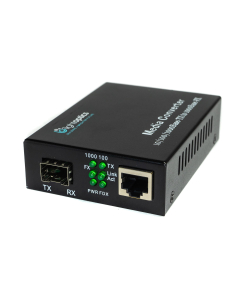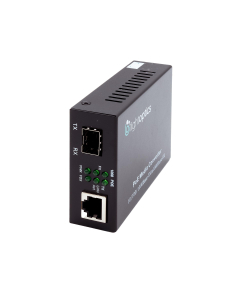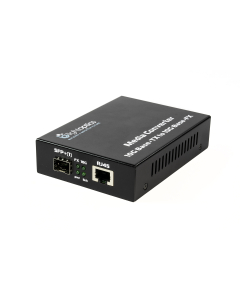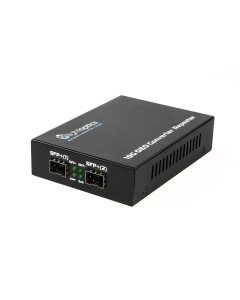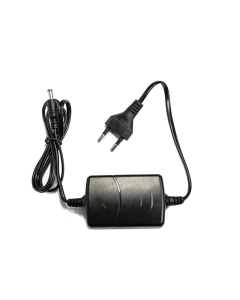- Large availabilityMedia converter SFP na RJ45 1x 10/100/1000Base-TX, 1x 1000Base-FX SFP, dip switch Model: LO-MC-1000DMS€18.13 €22.30
- Large availabilityMedia converter SFP to SFP, extender/repeater, 2 ports SFP 100/1000M Model: LO-MC-1000C2S€20.58 €25.31
- Limited availabilityMedia converter PoE 1x 10/100/1000Base-T RJ45, 1x 1000M SFP Model: LO-MC-1000POE€36.26 €44.60
- Limited availabilitySFP to RJ45 10Gb media converter,10GBase-TX to 10GBase-FX repeater Model: LO-MC-10G-TSP€249.90 €307.38
- Limited availability10Gb SFP+ to SFP+ media converter with repeater function 2 10G SFP+ ports Model: LO-MC-10G-2SP€259.70 €319.43
- Large availabilityPower Supply Unit to LO-MC-1000DMS, AC 100-250V; DC 5V, 2A Model: LO-MC-PSU€5.88 €7.23
MEDIA CONVERTERS
WHAT IS A FIBER OPTIC MEDIA CONVERTER?
A fiber optic media converter is a networking device used to convert opto-electronic signals between twisted-pair and fiber optic cabling or between two different fiber optic cables. It can be, for example, a device converting signal between a copper interface of 10/100/1000Mb/s and a fiber interface of 1000Mb/s.
An interesting solution may be a fiber optic converter supporting the PoE/PoE+ technology, which can be used not only to convert the signal but also power the device over a single cable.
LIGHTOPTICS: MEDIA CONVERTERS ON A BUDGET
The LightOptics guarantees great quality at low price. We offer affordable and easy-to-use media converters that will suit all your needs.
Thanks to LED lights at the front of the device, you can easily monitor the operation of the optical converters.
The LO-MC-1000POE (1Gb) PoE/PoE+ Ethernet PoE/PoE+ media converter is designed for data transmission and powering long-range network devices. Its compatibility with 10/100/1000Base-TX/FX (SFP) provides numerous advantages. The converter can power devices compliant with the IEEE802.3af (15,4W) and IEEE802.3at (30W) standards, which allows network expansion even in locations lacking in power lines and sockets, or where WDM systems cannot be implemented.
Another application of the fiber optic converter (single-mode or multimode) is signal regeneration used to extend signal over longer distances.
HOW TO CHOOSE A MEDIA CONVERTER
When in doubt which media converter would best suit your needs, take into consideration the features given below:
- Transparency Mode informs that all interfaces of the device belong to the same LAN network therefore it is not necessary to adjust any network settings before adding a transparent device to the network. After the frame is bridged, it does not undergo any changes. Note that full transparency can be achieved with transponders.Converters on the other hand, can work in transparency mode. Every converter, even in transparency mode, is equipped with a “switch chip” which has some limitation, for example, as to the size of the frame.
- Thanks to the compatibility with the Jumbo frame, LAN efficiency can be extended. The maximum length of an Ethernet frame in a standard networking device equals 1,5kB (IEEE standard). Interface cards and switches supporting Jumbo technology have much longer frame capacity of an average length of 9kB.
- Flow Control is a technique that prevents data overflow on the receiving device. When the buffer of the output device is full, a signal is sent to the input device that delays the transmission until data processing in the buffer is finished.
- The Link Fault Pass-through (LFP) technology allows for the disconnection of the fiber optic port if a malfunction in the RJ45 port is detected. In case of an unexpected lack of connection between the switch and the media converter on the left side of the device, the RJ45 port on the right side disconnects , and as a result, the right-side switch detects lack of connection and ceases data transmission.
- Far End Fault (FEF) (802.3u standard) function disables the RJ45 ports in the media converter in case the fiber optic port gets disconnected, so that the switches on both sides of the network are informed about the connection malfunction.
- Spanning Tree Protocol (STP) (defined by the 802.1d standard) prevents LAN looping, ensures automatic topology reconfiguration of the network in case of emergency and optimizes path selection.
- The Automatic Laser Shutdown (ALS) mechanism causes automatic shutdown of the output power in case a fiber disconnection or fiber cuts are detected. It is a safety mechanism that prevents potentially harmful effects of laser leakage, under the condition that the ALS function is turned on both ends of the fiber.
- Standard PoE (Power over Ethernet) - it’s an electrical power supply technology that uses UTP cabling to transmit energy over peripheral devices that are part of the Ethernet network, such as VoIP devices, access points and webcams.
- Automatic Laser Shutdown ALS to technika wykorzystywana do automatycznego wyłączenia mocy wyjściowej nadajnika w przypadku przerwy włókna. Jest to funkcja bezpieczeństwa, która zapobiega niebezpiecznym skutkom pojawiania się światła laserowego w miejscu złamanego włókna, pod warunkiem, że funkcja ALS jest włączony na obu końcach pary włókien.
- Standard PoE Power over Ethernet – technologia przesyłu energii elektrycznej za pomocą okablowania UTP do urządzeń peryferyjnych będących elementami sieci Ethernet: urządzeń komunikacji VoIP, punktów dostępu, kamer internetowych itp.










